Is it possible to eat buckwheat with pancreatitis?
Pancreatitis is an acute or chronic inflammation of the pancreas. Regardless of the degree of damage to the gland and intoxication, it is important to pay special attention to nutrition at all stages of the disease. The diet is part of the complex therapy of the disease and is prescribed to each patient. A properly organized diet will alleviate the severity of symptoms, normalize metabolism, restore pancreatic function, and prevent relapses and progression of the disease.
Among the useful foods for people with pancreatitis is edible buckwheat, or common buckwheat. Buckwheat has excellent taste, high nutritional value, and ease of preparation of dishes based on it.
In the article below we will figure out whether or not you can eat buckwheat during pancreatitis and how it affects the gland during periods of exacerbation and remission.
Chemical composition, trace elements and vitamins in buckwheat
The taste and nutritional properties of buckwheat directly depend on the variety and quality of the product itself. Buckwheat goes on sale in four production forms:
- groats - whole, uncrushed grain, cleared of the surface shell;
- prodel (cut) - peeled coarsely chopped grains;
- Smolensk groats - finely ground grains;
- buckwheat flour.
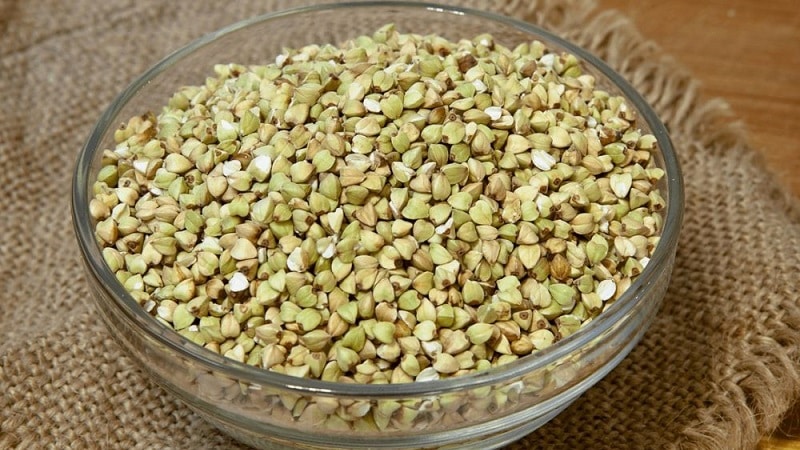
In addition to the usual dark or light brown grains, green (uncooked) buckwheat is gaining popularity. It is considered a healthy and dietary product; it is also used for preparing cereals and other dishes, but it costs two or more times more than regular processed cereals. In terms of usefulness for the body and availability when purchased, the most suitable is considered to be kernel cereal, as an alternative - prodel.
The energy value of whole grain cereals in raw form varies from 308 to 335 kcal. The glycemic index ranges from 50-60 units. During heat treatment, the nutritional value of the product decreases and amounts to:
- 101 kcal/100 g - boiled in water without salt and oil;
- 104 kcal/100g - steamed in hot water.
100 g of whole grain cereal contains:
- proteins - 12.6 g;
- fat - 3.3 g;
- carbohydrates - 57.1 g;
- water - 14 g;
- dietary fiber - 11.3 g.
Porridge made from buckwheat loses 2/3 of the calorie content of the raw product mainly due to the reduction in carbohydrate content. But the water concentration in the grain increases from 14 g to 75 g.
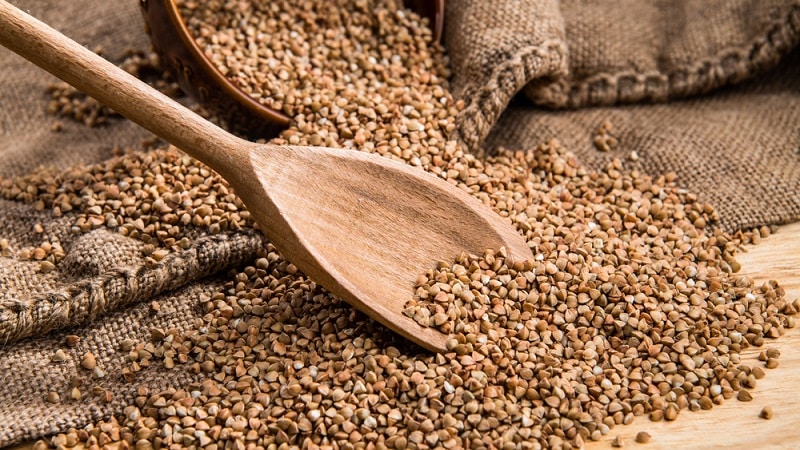
Buckwheat contains amino-, organic, omega-3 and omega-6 fatty acids, sterols. The carbohydrate component is represented by complex carbohydrates: fiber, starch, glycogen. They are slowly absorbed, smoothly increase blood sugar levels, and provide quick and long-lasting saturation of the body. Buckwheat proteins are superior to all cereal crops in terms of alpha amino acid content. They are characterized by high digestibility - up to 77%.
Vitamin composition includes:
- A (beta-carotene);
- B (thiamine, riboflavin, niacin, choline, pyridoxine, pantothenic and folic acids);
- E (alpha tocopherol);
- N (biotin);
- K (phylloquinone);
- PP (nicotinic acid).
Buckwheat is a valuable source of minerals: silicon, phosphorus, iron, copper, manganese, molybdenum, magnesium, potassium.To a lesser extent, it provides the body with calcium, sodium, sulfur, chlorine, iodine, selenium, fluorine, chromium, and zinc.
Consumption of other crops for pancreatitis:
Why oats are useful for pancreatitis and how to use them
Beneficial properties for the pancreas
One of the most important effects of buckwheat is cleansing the digestive system., ensuring proper functioning of the gastrointestinal tract. A sufficient amount of fiber in the kernel promotes the rapid removal of waste, toxins, and fat breakdown products from the intestines.
Regular consumption of cereals reduces bad cholesterol, blood glucose levels, helps cope with constipation, and prevents the formation of uric acid salts in the kidneys and gall bladder.
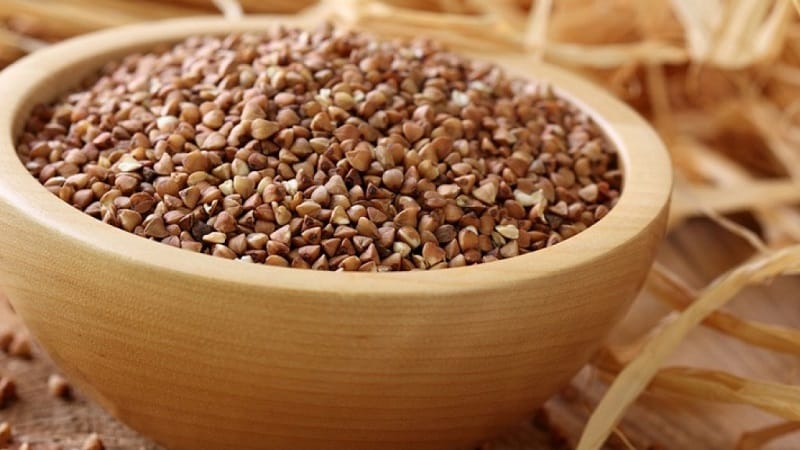
Buckwheat is rich in flavonoids, which have a pronounced antibacterial, anti-inflammatory, and antioxidant effect. Starch, present in the grain, acts as an enveloping agent, protects the mucous membranes of the gland from irritating substances, complicates their absorption, and reduces the intensity of painful sensations.
Attention! B vitamins, for which buckwheat is so valued, are involved in the metabolism of proteins, fats and carbohydrates, provide protection to mucous membranes, support energy production, and regulate redox reactions.
How does buckwheat affect the pancreas?
Buckwheat has different effects on pancreatic function depending on the stage of the disease and method of preparation. The most favorable period for introducing cereals into the diet is after the painful symptoms have reduced.
The benefits of buckwheat for the pancreas and the body as a whole depend on the variety and method of industrial processing of cereals. It is better to use kernels or green buckwheat. Also pay attention to its appearance and aroma. The presence of a foreign smell of mustiness, mold, or foreign inclusions in the form of insect pests indicates deterioration of the product.
During an exacerbation of pancreatitis
During the period of exacerbation of pancreatitis, the diet is limited. At this stage, it is important to reduce the load on the pancreas, and any food has an irritating effect and increases pain.
For the first two days, the diet includes only mineral water. (about 6 glasses), rosehip decoction, unsweetened green tea. The following days during the week, a strict diet with a minimum calorie content is prescribed. Viscous ground buckwheat porridge without oil, salt, or sugar is allowed. Low-calorie cottage cheese, zucchini, and lean meat are allowed.
Advice. During the period of acute pancreatitis, it is better to use prodel or flakes. Although they contain fewer vitamins and minerals than whole grains, they are more easily and quickly absorbed by the body.
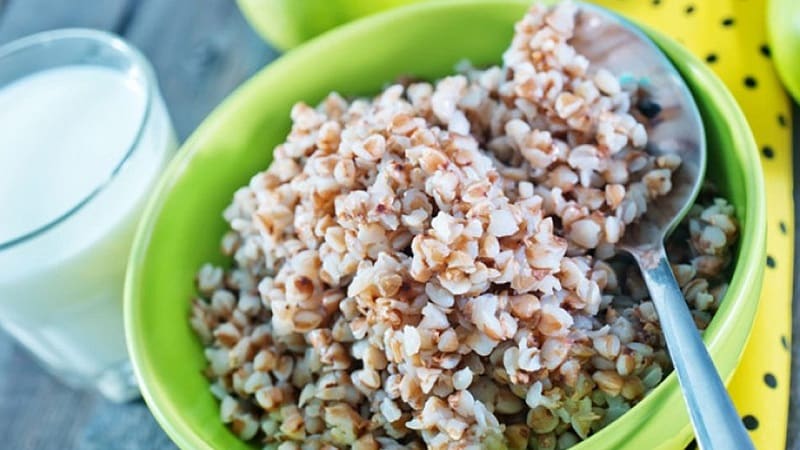
During remission
Since the patient needs protein, as soon as possible after the symptoms are relieved, they switch to a nutritious diet. During the interictal period, the diet becomes more calorie-rich and balanced. Compliance with this regime continues for many years.
After fasting, food begins with liquid carbohydrate foods. These are jelly, jellies, mousses, slimy soups, vegetable purees. Buckwheat kernels will also be useful. It is added to vegetable broths, the porridge is boiled in water and ground. The main thing is that the food is warm, but not hot.If the course of the disease is favorable, a ground version of buckwheat is prescribed for 1-2 months, then the degree of grinding of the product is reduced.
In addition to buckwheat, the diet includes:
- dietary meat, fish;
- low-fat cottage cheese, cheese, kefir;
- weakly concentrated broths, vegetarian soups;
- various cereals;
- omelette;
- vegetable fats;
- low fiber vegetables.
Coffee, chocolate, alcohol, sweet carbonated drinks, fatty meats are prohibited., fresh bread, sausages, fried foods, smoked meats, spicy, salty, mayonnaise, legumes.
Buckwheat for chronic pancreatitis
The therapeutic diet for chronic pancreatitis complies with the principles of a healthy diet. Buckwheat porridge must be present in the diet and other low-calorie dishes based on it.
In addition to buckwheat, it is important to enrich the diet with other cereal plants, the “right” products. The dietary menu must be agreed with your doctor, and then strictly followed.
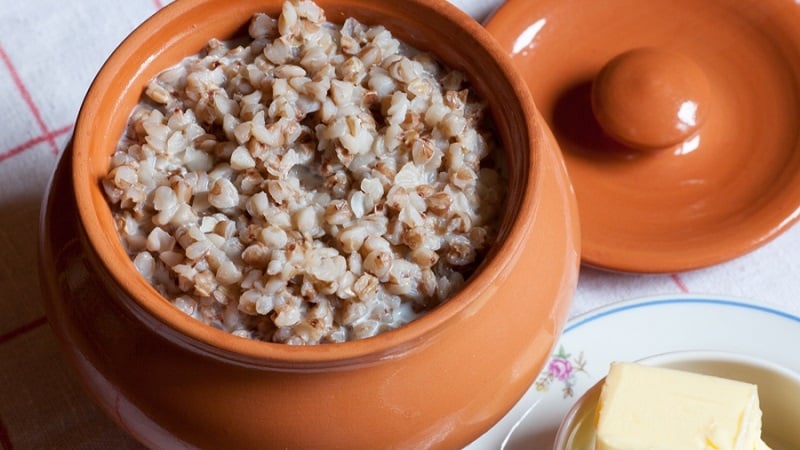
What products will buckwheat replace?
Buckwheat proteins are almost as good in biological value as meat and egg proteins and are superior to the proteins of many grain crops. Therefore, buckwheat to some extent can replace meat, eggs, and other cereals. Its obvious advantage over other grains is the absence of gluten, which often causes allergic reactions.
Read also:
Is it possible to eat watermelon with cholecystitis and pancreatitis?
Is it possible to eat melon with pancreatitis?
How to use dill seeds for pancreatitis and why they are useful
When it should not be eaten
Buckwheat contraindicated during periods of exacerbation of pancreatitis and other diseases digestive tract acute or chronic course.Do not use it in the diet if you are allergic to the product.
Due to the presence of vitamin P, buckwheat and dishes based on it are not recommended people with increased blood clotting.
Recipes with buckwheat for the treatment of pancreas
In clinical nutrition for pancreatitis, it is recommended to use buckwheat steamed with boiling water:
- 1 tbsp. Rinse quality grain until clear water.
- Pour 2 tbsp. boiling water
- Leave covered or in a thermos for several hours. It's better to do this at night.
With this method of preparation, the cereal retains maximum beneficial properties.. Valuable substances and nutritional components go directly into the grain itself, and are not washed out with water during the cooking process.
For reference. It is better to eat cereals without salt and sugar, seasoned with natural vegetable oil. Buckwheat porridge goes well with baked or steamed fresh vegetables.
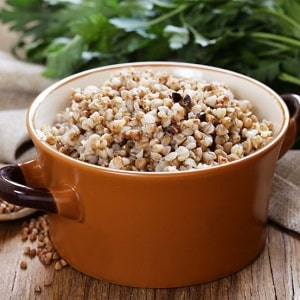 Diet cereal recipeprepared by boiling is also simple:
Diet cereal recipeprepared by boiling is also simple:
- Sort the grains, remove other grains, rinse until clear water.
- Pour the cereal into a saucepan and add cold water in a ratio of 1:2.
- Cook over low heat with the lid closed for 15-20 minutes.
When the taste of fresh, unseasoned cereal is unpleasant, You can add fresh herbs and any fruits except citrus fruits to the porridge. (for example, banana, baked apples), season with honey, low-fat milk.
Because Buckwheat goes well with meat and vegetables, dietary dishes based on it are varied and numerous. Buckwheat soup, porridge with vegetables and cabbage rolls with buckwheat are suitable for your daily diet.
Buckwheat soup
Ingredients:
- water - 2 l;
- core - 100 g;
- potatoes - 400 g;
- carrots - 1 pc.;
- onion - 1 head;
- chicken egg - 1 pc.;
- dill leaves, parsley;
- vegetable oil - 1-2 tbsp. l.;
- salt to taste.
Recipe:
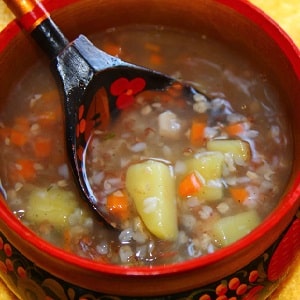 Sort out the buckwheat and rinse until the water is clear.
Sort out the buckwheat and rinse until the water is clear.- Peel the potatoes and cut into medium cubes.
- Grate the carrots on a coarse grater, finely chop the greens and onions.
- Prepare a weakly concentrated broth or boil purified water.
- Add onions, carrots, cereals, after 5 minutes - potatoes. Cook the soup until done, add salt at the end.
- Remove the pan from the stove, pour in vegetable oil and beaten egg in a thin stream.
- Before serving, decorate with herbs.
Buckwheat cabbage rolls
Products:
- egg grains - 1 tbsp.;
- water - 0.5 l;
- carrots - 2 pcs.;
- onions - 2 pcs.;
- cabbage leaves - as needed;
- greenery;
- vegetable oil to a minimum;
- spices to taste.
Cooking vegetarian cabbage rolls with buckwheat:
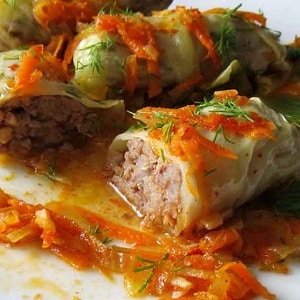 Rinse the cereal, steam with boiling water, let it brew for 2-3 hours so that the grains swell.
Rinse the cereal, steam with boiling water, let it brew for 2-3 hours so that the grains swell.- Chop the onion and grate the carrots. Fry the vegetables in a small amount of vegetable oil until golden brown.
- Prepare cabbage leaves: boil for 1-2 minutes in boiling water or place in the microwave for 3 minutes until softened.
- Mix the cereal with half the fried vegetables. Place the mixture in cabbage leaves and fold into an envelope.
- Place the cabbage rolls into a saucepan, sprinkle with the rest of the fried vegetables, and sprinkle with herbs.
- Fill them with water along the top edge. Simmer covered for 10-15 minutes.
Buckwheat with vegetables
Ingredients:
- purified water - 500 ml;
- buckwheat - 300 g;
- carrots - 1 pc.;
- zucchini - 1 pc.;
- onion - 1 pc.;
- salt - 5-7 g (possible without it).
Recipe:
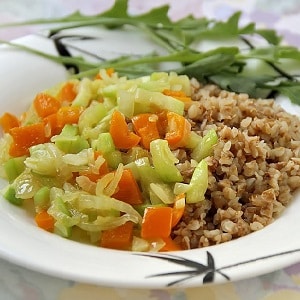 Cut the zucchini into medium-sized cubes, grate the carrots on a coarse grater, and cut the onion into half rings.Fry all vegetables until softened in a non-stick frying pan without oil.
Cut the zucchini into medium-sized cubes, grate the carrots on a coarse grater, and cut the onion into half rings.Fry all vegetables until softened in a non-stick frying pan without oil.- Sort out the grains and rinse with water.
- Place buckwheat and vegetables in a saucepan in layers. Pour water, put on low heat, cover with a lid.
- After the water boils, cook the porridge for approximately 15-20 minutes. You can eat the dish after half an hour, when the cereal is completely infused.
Buckwheat with kefir for pancreatitis
Kefir with buckwheat is useful for the pancreas in remission and for prevention pancreatitis. Kefir is an easily digestible product with low calorie content (36-40 kcal/100g). It contains practically no fats and carbohydrates, but saturates the body with calcium, potassium, fluorine, magnesium, cobalt, and copper. The composition contains high concentrations of vitamins A, D, E, PP, lacto- and bifidobacteria, which are necessary to normalize the intestinal microflora.
Buckwheat with kefir has a beneficial effect on pancreas, digestive system as a whole:
- inhibits inflammation;
- relieves and reduces pain intensity;
- regulates blood sugar levels;
- activates metabolism;
- improves digestion;
- restores gland function;
- Helps reduce and control weight.
Kefir is consumed together with porridge and separately. There are several options for preparing buckwheat porridge for therapeutic/dietary nutrition:
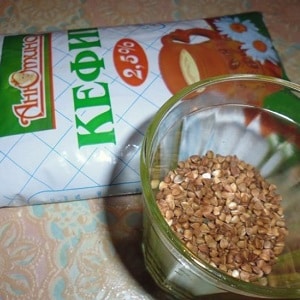 Steaming. Pour 200 g of washed buckwheat into 400 g of hot water. Leave in a tightly closed airtight container for 3-4 hours, wrapped in a towel. It is better to do this at night and in a thermos.
Steaming. Pour 200 g of washed buckwheat into 400 g of hot water. Leave in a tightly closed airtight container for 3-4 hours, wrapped in a towel. It is better to do this at night and in a thermos.- Buckwheat doused with kefir. 1 tbsp. buckwheat pour 2 tbsp. low-fat kefir. Leave in a sealed container for a day at room temperature.
- Cooked buckwheat porridge.Rinse 200 g of buckwheat, add 400 ml of cold water, cook over low heat for 10-15 minutes until tender.
Kefir with buckwheat porridge can cause a laxative effect, which is why the dish is not recommended for diarrhea.
Attention. Kefir made less than a day ago has a laxative effect, more than three days ago it causes constipation.
It is preferable to separate the intake of buckwheat porridge and kefir. It is better to take the drink half an hour before porridge. But if you find it difficult to eat a bland dish, it is better to combine these two products.
It is recommended to follow this diet for no more than 7-10 days in a row.. In addition to kefir and buckwheat, the diet should contain other healthy foods and plenty of free liquid. For chronic pancreatitis, a diet of buckwheat and kefir is recommended every 3 months.
Conclusion
If you choose the right diet, you can delay the onset of relapse and prevent complications. Considering the rich vitamin and mineral composition of buckwheat, dishes based on it must be present in the diet of patients with pancreatitis during remission and the chronic course of the pathology.
Positive reviews from those who followed a diet for pancreatitis prove that a properly organized diet serves as a good prevention of relapses and progression of inflammation, improves metabolic processes in the pancreas, and restores its functions.